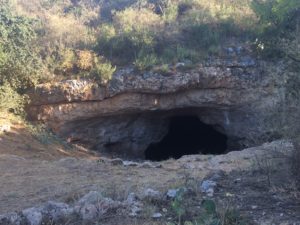
Come walk with me.
Past rattlesnakes resting under shaded arms of prickly pear.
Past roadrunners hunting, dashing, searching.
Over hardpan ground to a place where a gaping hole in the land lies hidden, a portal into a shadowy, winged world.
*******
The cave opening sits sunken into the hillside like a large, obsidian eye. It is a particularly important cave, protected by a small nature preserve where I worked as a young wildlife biologist many years ago. Every summer, it transforms into a sweltering, ill-smelling incubator, its wide mouth sloping down into a chasmal belly that meets the exacting needs of its summer inhabitants: nearly four million Mexican free-tailed and cave myotis bats. All are expectant mothers who, like so many other mothers in summer, are looking for a safe place to give birth.
Several nights a week, visitors ramble down dirt roads and trek through rivers and washes to reach the preserve. Their adventure continues on foot along a trail lined with beebrush and tasajillo, a less-showy, but equally lively, relative of the prickly pear. When they round the last bend in the trail, they look up and finally get their first glimpse of the cave. Struck silent, they stare. Nature has commanded their full attention. Their trance is broken when the first acrid whiff of urine and ammonia billows up from the cave, and they cough and cover their noses, amazement replaced with repulsion.
Along the top of the entrance, western coachwhip snakes search the cracks between the layers of thick gray limestone. Their noses poke in and out of crevices as they hunt for a lone bat, one who huddles sick or hurt or who has simply strayed too far from his mother. Sometimes, only the coachwhip’s dusty yellow head is visible, the rest of her body hidden deep inside a crack. Her vacant stare makes it hard to tell if she is asleep or awake until her glossy tongue slides out, flicking up, then down, then back up again, tasting the air.
The seating area above the entrance is now filled with expectant faces. We all stare at the cavern below.
We wait. And wait.

Some evenings, a portly raccoon ambles out from the far corner of the entrance, stops at the edge of the darkness, and looks up at us as we look down at him. He climbs onto a rock ledge, reaches a prying hand back into the black hole, and plucks a bat off the cave wall. Completely engrossed, we almost miss the first bat as she circles out, then back in. She circles out once more before disappearing back into the cave.
Not quite time yet.
The raccoon now holds his meal by the wings, bites off her head and consumes the rest of her furry body before dropping her wings to the ground.
Minutes later, another bat emerges, this time followed by two more bats, then ten, then fifty, then hundreds. A tornadic explosion of orderly chaos, they pour out. Blurred brown bodies flapping and clicking and swirling. Wind spawned from hundreds of wings brushes our bare skin. The unlucky ones, crowded to the outermost spirals crash into shrubs and low-lying branches, their wings impaled on twigs. But torn skin is not their plight; that will grow back. It is the hungry raccoons, coachwhips, and whipsnakes hoping for full-bellied sleep.
Up higher, the spiral unwraps itself, casting ascending ribbons into the horizon. Like the snakes below, hawks survey from above, perching on the tops of the tallest oak trees. One hawk, perhaps a mother herself, leaves her branch and flies to the ribbons. Steadying her wings, she glances right and left. Then, with no warning, she swings her feet forward, smooth talons leading the way. Panicked bats scatter. The fortunate ones reunite further downstream as the ribbons continue drifting upwards.

As twilight dims our vision, visitors trickle back up the trail. Repulsion replaced once again with amazement, they express gratitude for the bats; occasionally, even the snakes receive compliments. With most free-tailed bats gone, mother myotis bats now have room to leave their roosting area further back in the cave. Their emergence is less dramatic; they simply fly out and immediately commence hunting, swooping low through the trees. As the night world awakens, I think about the millions of battles waging on over the land; many lives lost so many others might live.
Some nights, walking back to my car, that wondrous celestial companion rises up over the trees and walks with me. At her fullest, she drapes the air in silver and stillness. When she stays hidden, the land transforms into a sanctuary of darkness. Deep quiet settles over the hills; every faint footstep, low growl, and falling leaf pierces the air. A poorwill repeats his soft serenade, poor-wilip, poor-wilip, poor-wilip. I imagine him sitting on the bare ground alone, his black saucer eyes watchful, wary.
Sitting on the hood of my car, not yet ready to leave, I listen to the poorwill a few more minutes until he falls silent, perhaps moving to another hill. Without him, the drones and trills of insects drift into awareness. This unhurried world makes sense to me. Life and death, hunger and need, raw survival are real and constant. There are no guarantees of safety, no false security behind pretense and walls and white picket fences. Everything is as it seems: a hawk perched high waiting for a ribbon of bats is exactly as it appears, no more, no less.
We are a part of this, too. But our heated houses and sunless lights deceive us. No longer must we walk to the creek to satisfy our thirst or kill our food with our own hands. By damming our rivers and subduing our animals and their lands, we believe it all to be limitless. We believe we can take as much as we want. We believe our survival is guaranteed.
We have fallen prey to The Great Delusion.
Nature offers an antidote. Nature reminds us we belong. We drink from the same waters and share the same air. And we are guided by the same natural laws as every fungi, insect, mouse, and marten. In between our birth and death, we all scramble to survive. In this mighty endeavor, we harm and are harmed, help and are helped, heal and are healed. We still have much to learn.
But we must listen.
We must listen deeply and often.
We must listen with humility, with curiosity, and with appreciation.
Come with me.
A great evocative description of predator and prey going about their daily business, beautiful and terrible. Thanks for reminding us that our own daily business is a Great Delusion, as it conceals our relationship with nature and makes us think we are a separate thing, above its laws.
This is a beautifully written and evocative piece. It takes the reader on a stunning journey through the sights, sounds, and smells of the bat cave.
The descriptions are so vivid, I could almost feel the prickling heat and smell the ammonia-tinged air.
You captured the awe-inspiring spectacle of the bat emergence perfectly, the chaos and vulnerability alongside the sheer wonder of nature.
The contrast between the human observers and the natural world is profound. The reminder that “life and death, hunger and need” are constant realities is a powerful one.
This piece is more than just a nature observation, it’s a call to action. A call to listen, to be humble, and to appreciate the interconnectedness of all living things.
The closing line, “We must listen. We must listen deeply and often. We must listen with humility, with curiosity, and with appreciation,” is particularly inspiring.
Thank you for sharing this!
This is an absolute best blog I have ever read.